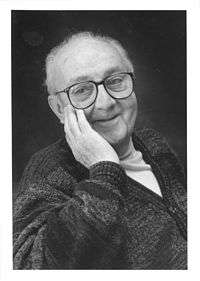George E. P. Box
| George Box | |
|---|---|
 | |
| Born |
George Edward Pelham Box 18 October 1919 Gravesend, Kent, England |
| Died |
28 March 2013 (aged 93) Madison, Wisconsin |
| Residence | United Kingdom, United States |
| Fields | |
| Institutions | |
| Alma mater | University College London |
| Thesis | Departures from Independence and Homoscedastisity in the Analysis of Variance and Related Statistical Analysis (1953) |
| Doctoral advisor | |
| Doctoral students |
|
| Known for | |
| Influences | Ronald Fisher |
| Influenced |
Norman Draper George C. Tiao |
| Notable awards |
|
George Edward Pelham Box FRS[2] (18 October 1919 – 28 March 2013) was a statistician, who worked in the areas of quality control, time-series analysis, design of experiments, and Bayesian inference. He has been called "one of the great statistical minds of the 20th century".[3][4][5][6]
Education and early life
He was born in Gravesend, Kent, England. Upon entering university he began to study chemistry, but was called up for service before finishing. During World War II, he performed experiments for the British Army exposing small animals to poison gas. To analyze the results of his experiments, he taught himself statistics from available texts. After the war, he enrolled at University College London and obtained a bachelor's degree in mathematics and statistics. He received a Ph.D. from the University of London in 1953, under the supervision of Egon Pearson.[1][7]
Career and research
From 1948 to 1956, Box worked as a statistician for Imperial Chemical Industries (ICI). While at ICI, he took a leave of absence for a year and served as a visiting professor at the North Carolina State University at Raleigh (now North Carolina State University). He later went to Princeton University where he served as Director of the Statistical Research Group.
In 1960, Box moved to the University of Wisconsin–Madison to create the Department of Statistics. He was appointed Vilas Research Professor of Statistics (the highest honor accorded to any faculty member at the University of Wisconsin–Madison) in 1980.[8] Box and Bill Hunter co-founded the Center for Quality and Productivity Improvement at the University of Wisconsin–Madison in 1984. Box officially retired in 1992, becoming an Emeritus Professor.
Box published books including Statistics for Experimenters (2nd ed., 2005), Time Series Analysis: Forecasting and Control (4th ed., 2008, with Gwilym Jenkins and Gregory C. Reinsel) and Bayesian Inference in Statistical Analysis. (1973, with George C. Tiao).
Awards and honours
Box served as President of the American Statistical Association in 1978 and of the Institute of Mathematical Statistics in 1979. He received the Shewhart Medal from the American Society for Quality Control in 1968, the Wilks Memorial Award from the American Statistical Association in 1972, the R. A. Fisher Lectureship in 1974, and the Guy Medal in Gold from the Royal Statistical Society in 1993. Box was elected a member of the American Academy of Arts and Sciences in 1974 and a Fellow of the Royal Society (FRS) in 1985.[2]
His name is associated with results in statistics such as Box–Jenkins models, Box–Cox transformations, Box–Behnken designs, and others. Box wrote that "essentially, all models are wrong, but some are useful" in his book on response surface methodology with Norman R. Draper.[9]
Personal life
Box married Joan Fisher, the second of Ronald Fisher's five daughters. In 1978, Joan Fisher Box published a biography of Ronald Fisher, with substantial collaboration of Box.[10] Box married Claire Quist in 1985.
Box died on 28 March 2013. He was 93 years old.[2][11]
References
- 1 2 3 George E. P. Box at the Mathematics Genealogy Project
- 1 2 3 4 Smith, A. F. M. (2015). "George Edward Pelham Box. 10 October 1919 — 28 March 2013". Biographical Memoirs of Fellows of the Royal Society 61. doi:10.1098/rsbm.2015.0015. ISSN 0080-4606.
- ↑ Julian Champkin, "George Box, (1919-2013): a wit, a kind man and a statistician", Significance.
- ↑ Morris H. DeGroot (August 1987). "A Conversation with George Box". Statistical Science 2 (3): 239–258. doi:10.1214/ss/1177013223. JSTOR 2245757.
- ↑ Daniel Peña (2001). "George Box: An interview with the International Journal of Forecasting" (PDF). International Journal of Forecasting 17: 1–9.
- ↑ Colin Beveridge (5 April 2013). "George E. P. Box (1919-2013)". The Aperiodical.
- ↑ O'Connor, John J.; Robertson, Edmund F., "George E. P. Box", MacTutor History of Mathematics archive, University of St Andrews.
- ↑ George Box University of Wisconsin–Madison home page
- ↑ Box, George E. P.; Norman R. Draper (1987). Empirical Model-Building and Response Surfaces, p. 424, Wiley. ISBN 0-471-81033-9. (more details at wikiquote)
- ↑ Box, Joan Fisher (1978) R. A. Fisher: The Life of a Scientist Preface, ISBN 0-471-09300-9
- ↑ Bradley Jones. "George Box: A remembrance". SAS Institute Inc. Retrieved 5 April 2013.
External links
| Wikiquote has quotations related to: George E. P. Box |
- Box-Behnken designs from a handbook on engineering statistics at NIST
- ASQ: George E.P. Box Accomplishments in statistics
- Articles and Reports by George Box
- Statistics for Experimenters - Second Edition, 2005 by George Box, William G. Hunter and Stuart Hunter
| ||||||||||||||||||||||||||||||||
|